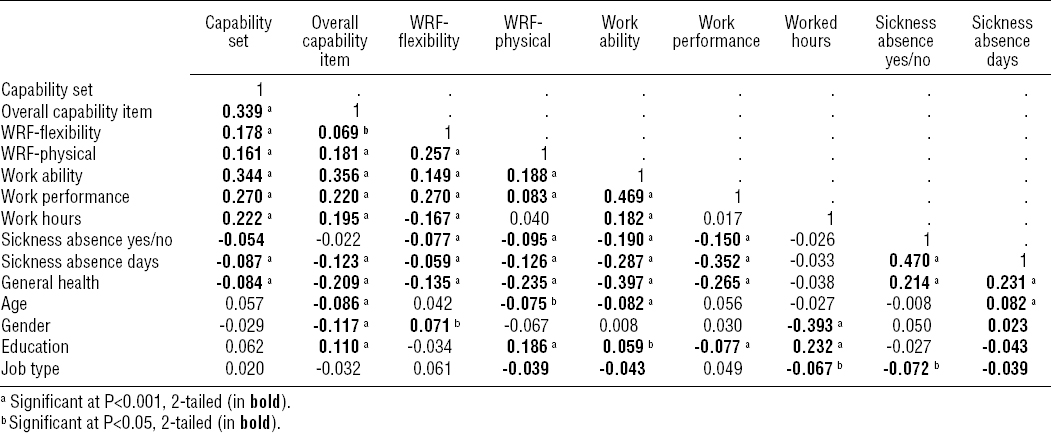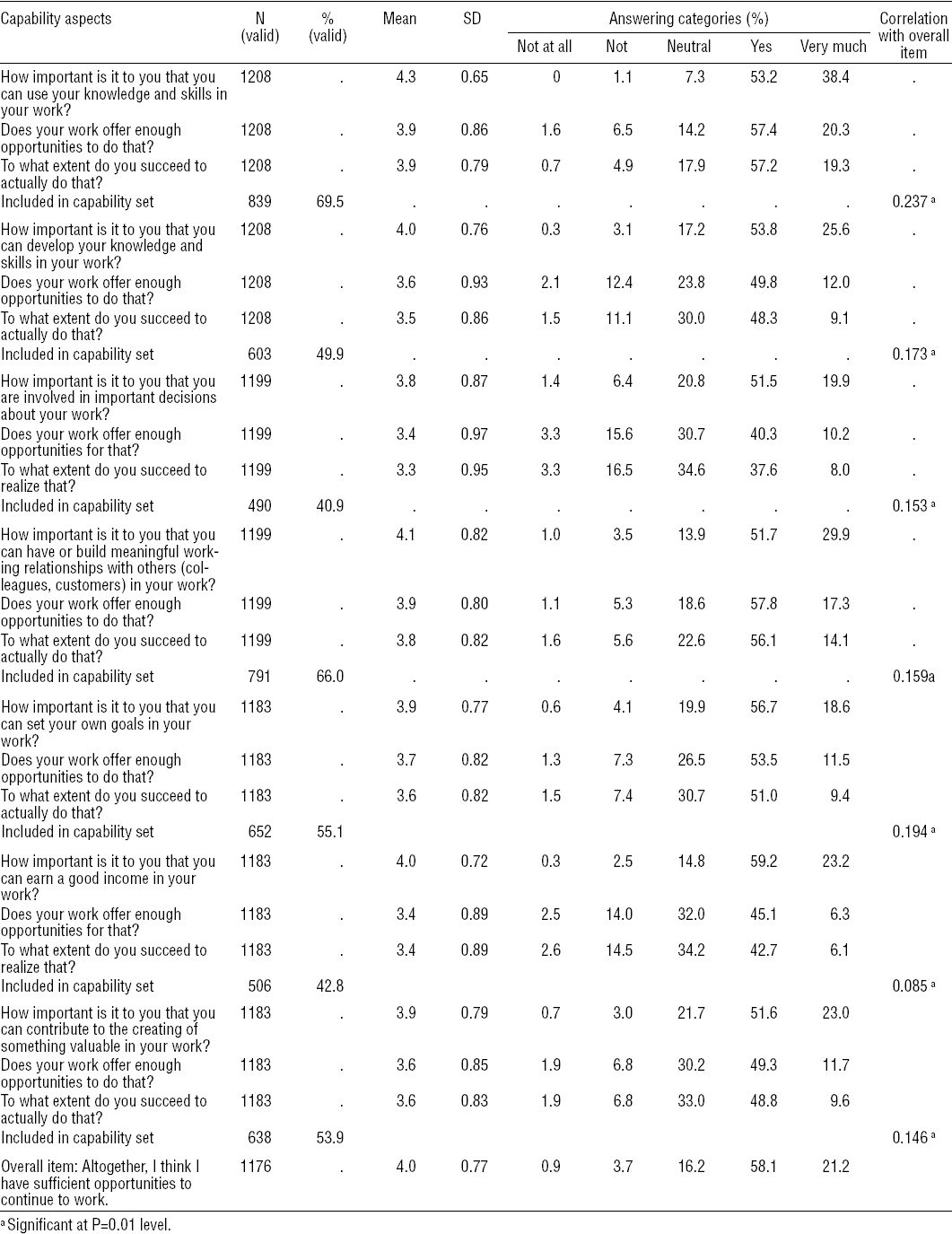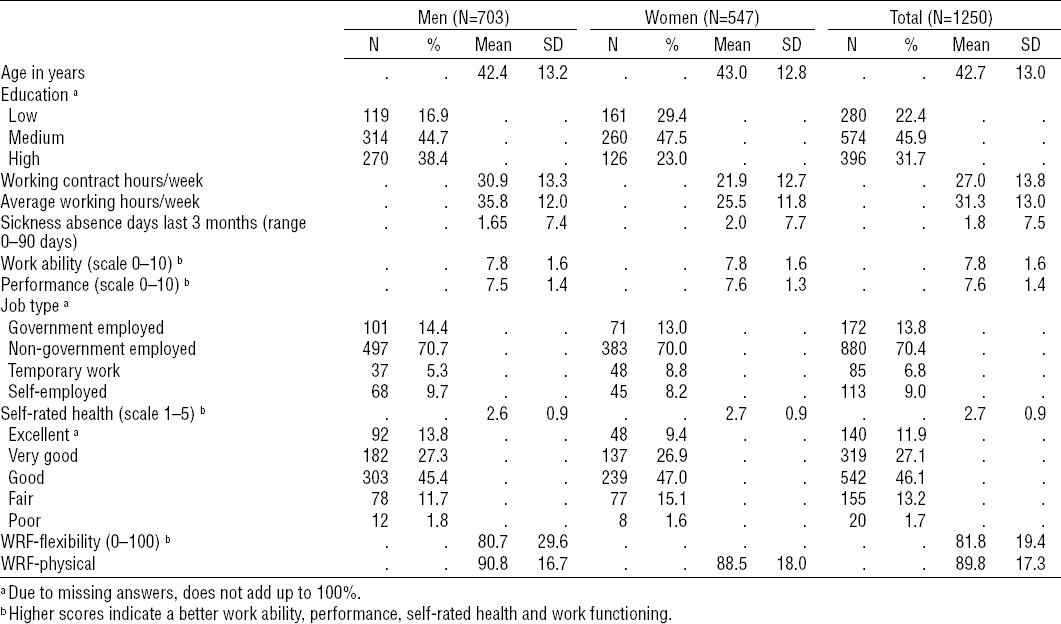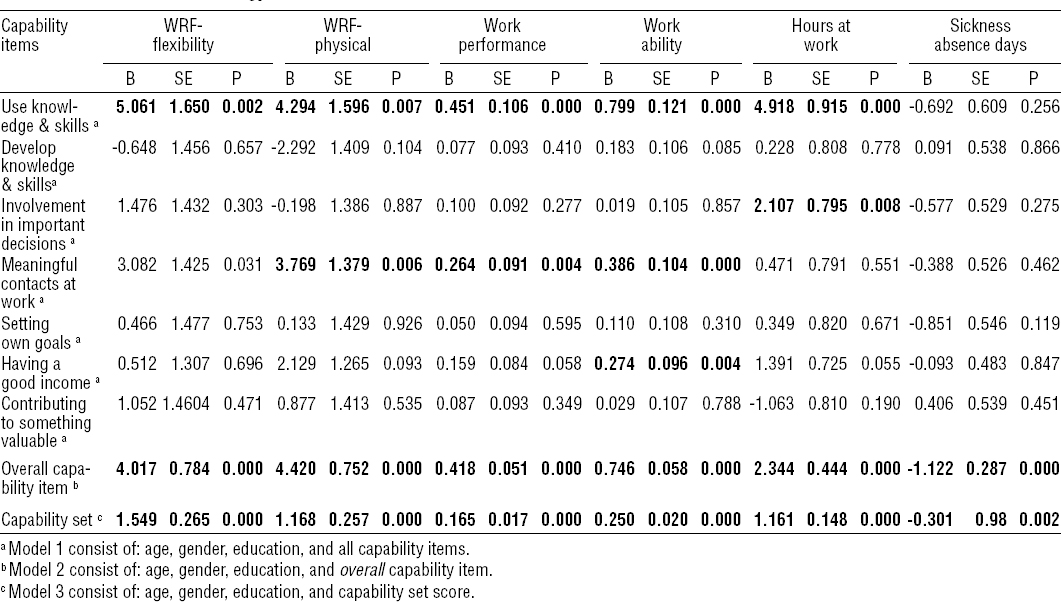In many countries, governments stimulate participation of older workers by an increase of retirement age combined with a decrease of possibilities for early retirement (1), leading to an ageing workforce. Because older people are more likely to have a chronic disease(s), an increase of workers with health problems in the workforce is expected. At the same time, criteria for awarding disability benefits are getting stricter, giving rise to the question how to enable workers to participate in work in a sustainable way. On the personal, organizational, and societal level it is important that people experience work not as a burden but as a valuable part of their life course. This is a challenge that requires renewed attention for the interrelationship between work and health, with a special focus on sustainable employability and the importance of valued work.
Employability is not new and several definitions and conceptual models exist. Up to now, there is no clear consensus about the definition and measurement (2). Most definitions focus on the employability of the individual and do not take contextual factors into account (3). Van der Klink et al developed a new comprehensive definition and a conceptual model of sustainable employability (4–6) based on Amartya Sen’s capability approach (7): “Sustainable employability means that, throughout their working lives, workers can realize tangible opportunities in the form of a set of capabilities. They also enjoy the necessary conditions that allow them to make a valuable contribution through their work, now and in the future, while safeguarding their health and welfare. This requires on the one hand a work context that facilitates them, and on the other hand the attitude and motivation to exploit these opportunities” (p4, 8). The definition, conceptual model, and construct of sustainable employability as capability are described in full detail elsewhere in this issue in van der Klink et al’s Discussion Paper (8). This new definition of sustainable employability challenges researchers, policy makers, and practitioners to ascertain what is important and valuable in a given (work) context, and investigate whether people are able and enabled to achieve this.
The definition is based on the notion that work in the context of our current society should add value, contribute to health, and should be sustainable. In the conceptual model, health is conceived as the ability to adapt and to self-manage, a formulation recently proposed by Huber et al (9). By successfully adapting to an illness or disease condition, people are able to participate in work or in other relevant and valued societal activities. Following Sen’s capability approach, van der Klink’s sustainable employability model theorizes that it is important to know what people value in their work and whether they are able and enabled to realize these aspects to support their sustainable employability.
Several instruments based on the capability approach exist in other domains [for example ICECAP (10) and ICECAP-A (11), an instrument evaluating public health interventions (12), a quality of life instrument, and an instrument measuring capabilities and achievement (13)]. Although there is a body of evidence on values and work [ie, (15–17)] and several instruments exist that investigate which aspects of work are valued [eg, Minnesota Importance Questionnaire, Super’s Work Values Inventory, Manhardt’s Work Values Inventory, see for overview (18)], these instruments often only inventory these work values. The capability approach can give an extra dimension and direction to these values because it also takes account of what people are able and enabled to achieve and sets standards for personal and organizational responsibilities (8). Notwithstanding this potential, the capability approach, although applied in many areas, has not yet extensively been used in the domain of work (10, 19, 20), and no instrument has yet been developed to assess work capabilities.
Essential to the concept of capability is that people are able and enabled to realize beings and doings they have reason to value (7). It is hypothesized that a sufficiently comprehensive set of work capabilities results in better work outcomes, such as work functioning (hypothesis 1), work performance (hypothesis 2), work ability (hypothesis 3), lower sickness absence (hypothesis 4), more hours worked (hypothesis 5) and years worked (hypothesis 6), eventually leading to sustainable employability. In contrast, when people are not able to get out of work what they value, a discrepancy occurs between what is valued and what is enabled and can be realized in work, with the result that their sustainable employability may be at risk. The fact that workers have a set of options (eg, a capability set) from which they can choose makes them less vulnerable to changes, eg, in their (work) environment or health status, and this is likely to contribute to their sustained employability. Hence, the assumption is that the larger the capability set, the better a worker’s sustainable employability throughout working life.
The aim of this study was to identify work capabilities – valued aspects of work that are enabled and can be realized – and develop a questionnaire to measure the capability set in the general working population (ie, what is valued in work and whether this is enabled and realized). In addition, the validity of the questionnaire was evaluated by means of hypotheses testing.
Methods
Identifying valued aspects of work
In our construction of the list of capabilities in work that are relevant for sustainable employability, we incorporated workers’ opinions of what they value in work. This is in accordance with Sen’s view that the capabilities should not be determined by theorists, but by explicitly engaging the persons involved in the particular context (7). In addition, to check the completeness of our findings, we systematically evaluated what people value in their work through a search of the literature. Ultimately, to complete and confine the set, we had an expert meeting with a group of researchers.
Fourteen interviews were conducted with workers (employee (N=5), self-employed (N=4), early-retired people who are still active in paid employment (<65 years) (N=3), and retired people (>65) (N=2) to explore what is needed for workers to value their work and to continue working. Participants were recruited via a local newspaper. A convenience sample was used with no age restriction because it was expected that especially those workers who chose to continue working after retirement age would have valuable input about what is needed for sustainable employability. The interviews lasted on average one hour and took place at the participants’ homes or at a university hospital (Department of Health Sciences) in the Northern part of the Netherlands. The interviews were recorded and transcribed verbatim. The data were thematically analyzed based on the qualitative description method described by Sandelowski (21) and the analytic hierarchy method described by Richie & Lewis (22). Two authors individually read the transcripts and, by assigning meaning to groups of words, identified initial themes. These themes were sorted and summarized. The two authors discussed the themes until consensus was reached. Subsequently, related themes were grouped into categories. This iterative process was conducted manually and documented in tables.
In addition, the literature was searched to identify possible additional valued aspects of work measured with (validated) instruments. The following databases were searched: Academic search premier, Business Source premier, EconLit, Medline, PsycInfo and SocIndex using EBSCOHOST. Search terms such as “work value”, “attitude”, “centrality”, “meaning of work”, were combined with terms as “questionnaire” or “scale”.
In an expert meeting with the research team, the input from the literature and the interviews were discussed until consensus was reached to select the values for the capability set for work. The results from the interview study guided the identification and development processes.
Subsequently, the selected valued aspects of work were converted to questionnaire items to measure the capability set for work. Staying close to the concept of capability, for each valued aspect, workers were asked whether: (A) they think this aspect is important to them – to assess whether the aspect of work is considered valuable, (B) their work offers them sufficient opportunities to do it – to assess if they have a resourceful work environment which enables him or her to realize the aspect of work, and (C) they are able to succeed in realizing it – to assess if they have the capacity and competencies to realize the aspect of work. The order of the items were always in the same order: first (A), than (B) then (C). Answering categories were: 1=“not at all”; 2=“not”, 3=“neutral”, 4=“yes”, and 5=“very much” (see table 1).
To assess whether a capability aspect is part of a worker’s capability set, a summary measure was calculated for each capability aspect. A capability aspect is part of the capability set if a worker finds an aspect important, is enabled, and is able to succeed in achieving the aspect. This allows testing the hypothesis that workers who find a capability important (A), but have no opportunities in their work to realize it (B) or do not succeed (themselves) in realizing it (C), have worse outcomes than workers who find it important and have sufficient opportunities at work and succeed in realizing. A capability aspect was scored (range 1–5) as part of the capability set when a capability aspect was scored important (A=4–5) and the workplace as offering sufficient opportunities (B=4–5) and being able to realize it (C=4–5). Likewise, a capability aspect was scored as not part of the capability set when workers scored: (i) the capability as important (A=4–5) but the workplace as not offering sufficient opportunities (B=≤3); (ii) the capability as important (A=4–5) but themselves as not being able to realize it (C=≤3); or (iii) the workplace as offering sufficient opportunities (B=4–5) but themselves as not being able to realize it (C=≤3). When a capability was scored as not important (A=≤3) it was considered as not part of the capability set.
In addition, an overall question about the capability set for work was formulated. This question is based on Anand and van Hees (19) who developed an overall question that could be directed towards several capability aspects. It was decided to formulate such an overall question for the capability for work: “Taken all things together, I think I have enough opportunities to remain working” (answering categories: 1=“totally disagree”; 2=“disagree”, 3=“don’t disagree/don’t agree”, 4=“agree”, and 5=“totally agree”).
Administering and validation of the questionnaire
A large survey was conducted to evaluate the construct validity by means of hypotheses testing (23) of the new capability for work questionnaire. A panel agency was used to obtain a representative sample of the Dutch working population. The participants in the panel (N=16 000) who were in the working age (16–70 years) were selected and N=2489 were invited to participate. Participants provided online informed consent and obtained points for participation (a certain amount of points could be transferred into a gift voucher). In addition to the new capability for work questionnaire, other concepts were included to validate the new questionnaire.
As for ethical standards, in this study we adhered to the Declaration of Helsinki and the guidelines of the association of universities in the Netherlands (24). According to the medical ethics committee of the University Medical Center Groningen, no ethical approval was necessary. Participation in the study was voluntary and answers were processed anonymously.
Measures
The following measures were included to evaluate construct validity. All items were included in the same order for all participants.
Work ability was measured with the single overall item of the Work Ability Index (WAI) (25), “current work ability compared with the lifetime best”, with a possible score of 0=completely unable to work to 10=work ability at its best. Work role functioning (WRF) was measured with two subscales of the Work Role Functioning Questionnaire 2.0 (WRFQ) (26): physical (WRF-P) and flexibility (WRF-F) demands. The WRFQ measures the perceived difficulties in meeting work demands among employees given their physical health or emotional problems. The recall period is 4 weeks and the response options range on a 5-point scale from 0=difficult all the time (100%), 1=difficult most of the time, 2=difficult half of the time (50%), 3=difficult some of the time, 4=difficult none of the time (0%). There is also a response option “Does not apply to my job”. Subscale scores are summated separately by adding the answers in the subscale, divided by the number of items and then multiplied by 25 to obtain percentages between 0–100, with higher scores indicating better work functioning. The scores on “Does not apply to my job” were transformed to missing values. If ≥20% items were missing, the score was set to missing. Work performance was assessed with the World Health Organization’s Health and Work Performance Questionnaire (HPQ) (27). The HPQ is a reliable and valid self-rated work performance measure, scored as percentage of performance on a 0–10 response scale, where 0 represents a total lack of performance and 10 no lack of performance during time of the job in the past 4 weeks. Current hours at work was measured in hours per week. Sickness absence was measured in absence due to sickness yes/no and days absent due to sickness in the past 3 months. Self-rated health was measured with an overall question from the Short Form (SF) 12 (28) “In general, how would you rate your health?” with the response categories “very good”, “good”, “fair”, “poor”, or “very poor”.
Statistical analysis
A dichotomized score was calculated for each capability aspect to identify whether this aspect is part of an individuals’ capability set (1=yes, 0=no). The combined score of all items resulted in a total score for the capability set. For construct validity by means of hypotheses testing (29), the score for the capability set and the dichotomized scores for the capability aspects were related to the other measures using Pearson correlations and regression analyses. Hypotheses were formulated based on the conceptual model for sustainable employability. Mean scores and standard deviations were calculated.
Hierarchical linear regression analyses were performed with the work outcomes as dependent variables. Age, gender and education were first included in the regression models to control for. The assumption was that a larger capability set is related with better (work) outcomes.
Results
Valued aspects of work
In the interview study, 20 themes were identified (see appendix A, www.sjweh.fi/data_repository.php). Early-retired participants all mentioned that they missed work for various reasons and that they had found ways to continue to participate in work (their former job or other work). Workers reported for example that work provides (financial) security, structure in life, identity (feeling needed in society), social aspects, and possibilities to use and develop knowledge. Work was seen as valuable if they enjoyed their work and if work offered support and trust. According to the participants, a good balance between work, other aspects of life (eg, leisure time, family), and aspects of health were needed to continue work.
The literature review included 49 different studies and identified seven work values that were rated as most important: ability utilization, achievement, discipline, fulfillment, interesting work, lifestyle, and loyalty.
In an expert group meeting, the aim, target population, content and scoring of the questionnaire were determined. The aim was to measure the capability set of workers (no age restriction). The results from the interviews and literature review were combined, discussed, and refined until consensus was reached on seven capability aspects (values) that form the basis of the capability set and are hypothesized to be important for sustainable employability: (i) use of knowledge and skills, (ii) development of knowledge and skills; (iii) involvement in important decisions; (iv) building and maintaining meaningful contacts at work; (v) Setting own goals; (vi) having a good income; and (vii) contributing to something valuable.
The items, together with the overall item were pretested with a small sample of workers (N=6), which led to the final wording, the order of the items, and the answering scale.
Quantitative study and sample characteristics
A total of N=1157 workers were included in the analyses (response 46.5%). Table 2 shows the characteristics of the sample. Participants were mainly employed in the healthcare sector (18%), other services (10%), education (8%), or the retail industry (8%). Women and men scored similar on most variables, except women had significant lower working hours per week and a lower educational level. However, the sample appears to be representative for the general Dutch working population.
Scoring of the capability aspects
For each capability aspect, the response category “definitely not” was only rarely scored (table 1). It was decided to maintain the response category “definitely not”, as we want to keep a (more sensitive to change) 5-point Likert scale, especially for use on an individual level. All “how important…” (A) questions of the capability aspects and a few “opportunities” (B) and “succeeded” (C) questions of the capability aspects had >15% scoring at the ceiling. There were no floor effects observed on any of the questions.
Even though only a small group had different scores on B and C items (98% of the participants scored the same response on both items), we decided to keep both items on conceptual grounds based on the assumption that the participants with differences between B and C are an interesting group because something is happening outside their work situation that hinders them from succeeding in realizing a work capability (for example health status or care duties).
Validity by means of hypotheses
The correlations are shown in table 3. Correlations of the seven individual capability aspects with the score of the capability set were between 0.555–0.710, and with the overall capability item (“taking all things together I think I have enough opportunities to remain working”) were between 0.182–0.339 (all P<0.001) (not shown in table). We hypothesized that the work-related constructs are correlated with the capability set (see introduction section for hypotheses). Significant, but low correlations were found between the capability set with work functioning, work performance, work ability, sickness absence, number of worked hours, and the overall capability item. In line with the hypotheses, the larger the capability set, the higher the scores were for work functioning, work performance, work ability, and number of hours worked. Moreover, a lower capability set was correlated with more sickness absence. Self-rated health was also significantly correlated with the capability set.
Table 3
Correlations between the capability set (discrepancy score) and overall capability item. [WRF=work role functioning.]

The multivariate analyses identified significant associations between various individual capability items and work outcomes, the overall capability item and work outcomes and the capability set and work outcomes (table 4). The results show different patterns for the various items. The overall item and the capability set score were significantly associated to all work outcomes.
Discussion
This paper describes the development and validation of a new questionnaire to measure a worker’s capability set for work based on Sen’s capability approach. The developed questionnaire is the operationalization of the capability set for work as described in the definition, conceptual model and construct of sustainable employability, as described in the paper by van der Klink et al (8). The capability set was significantly related to all work outcomes in the hypothesized direction and showed significant association in the regression models with all work outcomes.
The new capability set for work questionnaire appears to be a valid instrument to measure a worker’s capability set. The questionnaire is unique because the items include the valued aspects of work and incorporate whether a worker is able to achieve what (s)he values in his/her work. The questionnaire can be used to evaluate the capability set of workers in organizations to identify aspects that might need to be addressed in interventions to help workers stay at work.
The development was based on a combination of methods to define the capability set for work: interviews, literature study, and an expert meeting. Sen states that the identification of capabilities in a specific situation should be the result of a deliberative democratic process, explicitly engaging the persons involved. We concurred with this by regarding the results from the interviews as leading in the expert meeting. Moreover, through a literature review and interviews, we identified potential additional relevant valued aspects of work to overcome the risk of overlooking possible relevant aspects.
Recommendations for future use of the questionnaire
Based on theoretical arguments, we decided to keep both the opportunities (B items) and realizations (C items) in the questionnaire, although they were highly correlated. Further research is needed to study the assumption that something outside the work situation (for example health status) is hindering workers from succeeding in realizing the work capability and whether or not both items should be maintained in the questionnaire. This should be conducted especially in populations with health conditions or other vulnerable populations and situations, as the rather healthy population included in this study might be the reason for not finding differences between the B and C items.
For use on an individual level, we recommend to use the scores on the 5-point scale instead of the dichotomized scores. The 5-point scale answers provide more detailed information about the reason for a discrepancy on an individual capability aspect (whether an aspect is part of the capability set or not). For example, is the discrepancy due to the fact that the workplace does not offer sufficient opportunities or is there another reason why it is not possible to realize what is valued? This information can be used to identify ways to improve the sustainable employability of the individual worker. Interventions to improve the standard error based on a capability approach need to be developed. Further research is needed to study the measurement properties for use on individual level.
Strengths, limitations, and further research
To our knowledge, this questionnaire is the first to evaluate the capability set for work. The development was based on multiple sources and techniques (interviews, literature, expert opinion). However, the study has some limitations. First, a convenience sample was used to conduct the interviews, which may have limited the richness of the interview data and might not be representative of the general population. Second, the results may be influenced by some forms of common method bias (30) or artificial inflation of synchrony in answers, due to all survey data being self-reported by the worker at one point in time and items were always presented in the same order.
Several recommendations for future use of the instrument can be provided. Further validation of the questionnaire is needed – preferably in a longitudinal study design – to evaluate its completeness in the Dutch and other (specific) populations, such as older workers, and various occupational settings, as well as for use on the individual level and in other cultural contexts. To evaluate a worker’s sustainable employability, a longitudinal study with long-term follow-up is needed to evaluate the predictive validity of the questionnaire. Additionally, the relationships with existing psychosocial constructs, such as job control, should be explored. Future research should also explore whether a weight for the included valued aspects of work is needed. For example, for some workers earning an income is more important than for others. Additionally, it would be important to explore what a low value on all work aspects means.






